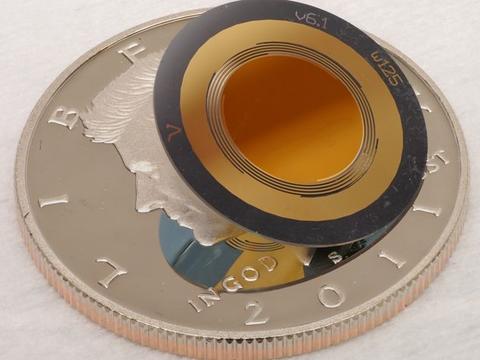Problem
The design overcomes the limitations of allowing simultaneous power measurement during laser use. The Smart Mirror's non-thermal approach reduces measurement time, allowing for better sensing of rapid changes in laser power.

A smart mirror prototype placed on a half-dollar coin. The mirrored center is suspended from Archimedean spiral springs. Different amounts of optical power displace the mirror and spring ensemble by different amounts.
Invention
The Smart Mirror is a device that accurately measures the power of laser sources without disturbing the laser beam. This is a promising technology for accurate monitoring of output power in industrial lasers that allows power measurement during the laser’s performance of its routine operations. Such high-accuracy, non-exclusive power monitoring has not been previously possible. The novelty is in a radically different approach where the laser power is determined by measuring the force of the light as it reflects from a mirror. This device operates across a power range of 25W to 500W.
Potential Commercial Applications
- Small, robust package for use on the factory floor.
Competitive Advantage
- This device is a miniaturized (less than 5 cm on a side), mirrored force sensor that combines several key elements to make the sensor smaller, faster, and more sensitive to force.
- Highly accurate measurements that can be made in real time.
- Can be calibrated in-house using standard reference masses.
- Does not absorb laser light.

